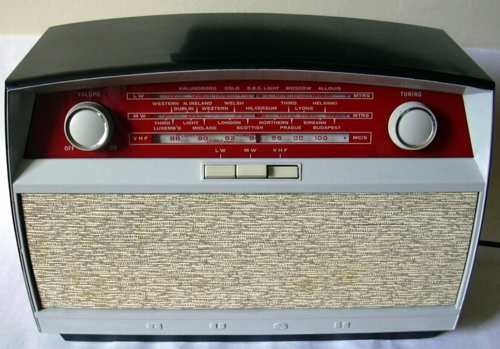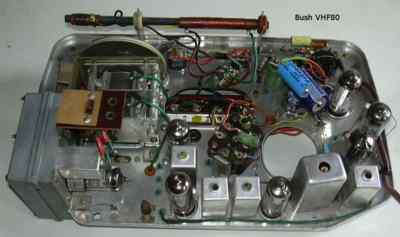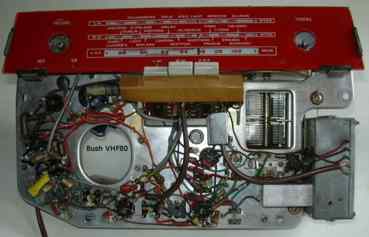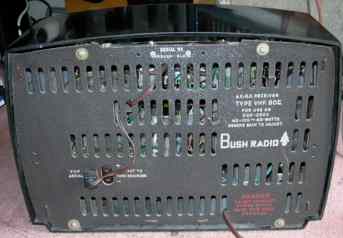

The VHF80 7 valve AC/DC radio was first introduced in February 1960 and cost £ 15 17s 2d plus purchase tax. It has long (1050-1935m), medium (187-560) and VHF (87.5-100 Mhz) bands. The valve line up is UCC85,UF89,UCH81,UF89,UABC80,UL84 and UY85. The VHF80C is a slightly later version. The elliptical Celestion 3 ohm speaker on my set is marked 4461, so I guess it was made towards the end of 1961.
As far as I have been able to find out the VHF80 and VHF80C are electrically the same, the former has gold trim and a black tuning scale, whereas the VHF80C has light grey trim and a red scale.
When I acquired this set in it was working and apparently complete but very dirty and the grey paint adjacent to the volume and tuning knobs had worn away in the past and had been poorly touched up.The first task was to remove the set, speaker and grille from the Bakelite case and to completely strip the existing grey paint from the areas above and below the speaker grille using "Nitromors" paint stripper and wash the case in hot water and washing up liquid. The case was then cleaned with "T-Cut" automobile polish reviver. The grey areas were repainted by hand using 3 coats of ordinary gloss paint and rubbing down with very fine "wet and dry" paper.
I then energised the set (foolish me, but it had been working previously) to find that one dial lamp glowed extremely brightly, failed and there was complete silence.


The replacement electrolytics were put in by the previous owner
Examination of the chassis revealed that someone in the past had replaced the tubular electrolytic capacitor with 3 separate items and there was a "rats nest" of new orange wires connected to a tag strip on the underside. The negative sides of the capacitors were connected to a loose earth tag and were making intermittent connection. I also discovered with the help of a circuit diagram (included on one of Paul Stenning's Vintage Radio Service Data CD Roms) that the replacements had been incorrectly wired! The mains filter capacitor C64 had exploded some time in the past and was in two pieces and the dial lamps were 6V 0.4A rather than 6V 0.15A. Apart from C53 an electrolytic in the discriminator section all other components except the valves appeared to be original.
Having discovered that I had a 3000mfd low voltage tubular capacitor of the right diameter to slip into the existing retaining clip. I cut off the end and removed the contents with a cork screw after warming it in boiling water and inserted the two 47 mfd capacitors inside it. The 22mfd axial capacitor was mounted below the chassis to the right hand side of the speaker opening.
I removed all the HT wires to the tag strip and individually labelled each and where appropriate changed the colours from orange to red for valves V1,V4 and V6 and connected them as originally intended. Eureka! it worked again. For some reason the wires to the tape recorder output sockets had been removed, the surplus orange wire was used to connect them to the out put transformer. All that was needed now was to clean the glass dial, flatten the white plastic diffuser (very hot water did the trick) behind it and re-assemble. I still have to purchase two dial lamps the 4v ones I have put in as a temporary measure glow rather dimly.

Some History
Bush rose from the ashes of Amplion who made speakers for British Gaumont cinemas and thus had links with the film industry.The radios were advertised in Gaumont cinema foyers as "A Gaumont British Product". Murphy experienced problems keeping at the forefront of technology and lost creditability with their dealers, many of which changed over to Bush. At some point Murphy became part of Bush and the company trade as Bush - Murphy in Chiswick, London. In 1945 because of their links to the film industry, Bush Murphy became part of the Rank empire and changed the name to Rank Bush Murphy (RBM). A new satellite factory was opened in Plymouth in 1949. During the mid 70's (When they were one of my major customers! I worked then for RCA Solid State having previously been with both Mullard & STC) ) they moved the entire operation to Plymouth. In 1972 the name was changed again to Rank Radio International (RRI). Following several years of mounting losses they tied up with the Japanese to become Rank Toshiba in 1978. This lasted just 3 years, and in 1981 finally folded. Toshiba became sole owner of the Plymouth factory. The Bush name now belongs (along with Alba) to an importers in Barking, E London.
Thanks to Colin Boggis for this information
Have a look at this site for a very comprehensive and interesting history of Bush radios http://www.bushradio.co.uk/